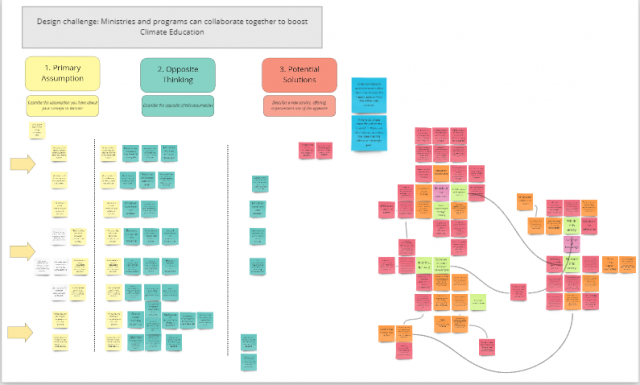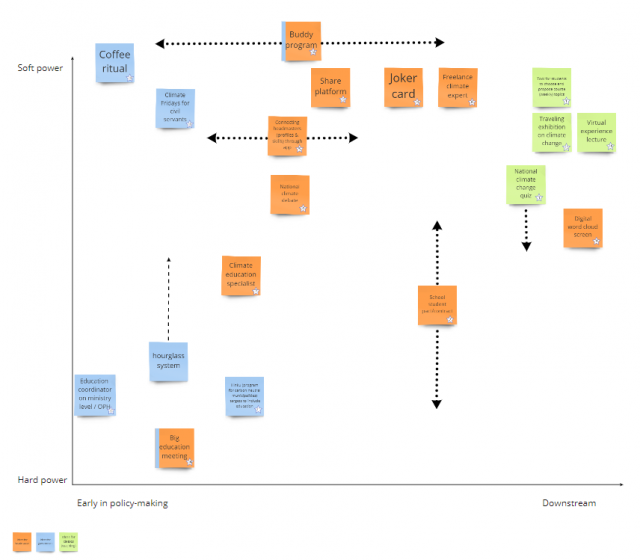This blog post reports on work-in-progress within the DfG course! The post is written by one of the two groups dealing with the Ministry of Environment’s brief on ‘Boosting Climate Education’. The group includes Zhengshuan Han, Noah Peysson, Rinna Saramäki, and Jelske van de Ven.
The Ministry of Education and Culture, the Ministry of Environment and ORSI research consortium’s brief, for Design for Government course, is looking for ways to boost climate education in Finland. Two previous blogs chart our progress from the initial workshop to getting to know the education landscape in Finland through research and interviews developing insights on climate education’s problems and opportunities.
Hence we found how boosting climate education can be approached on various levels from systemic to practical everyday issues. Our group identified numerous possible intervention spots, disjunctions in the system where information or intention does not proceed from an actor to another. These are problems that a well-thought-out design intervention can challenge? This profusion of possible opportunity areas was challenging, as initially none of the possibilities appeared to be immediately superior to the others.
Formulating design drivers and challenges
Design drivers are short, almost slogan-like sentences presenting the project’s goals and aim in a checklist manner so that they are not accidentally forgotten in the creative ideation phase.
Design challenges are key issues the project is tackling worded as questions, with actor, object, and action components.
We distilled our thinking into three design challenges:
1) How to design cooperation between the Ministry of Environment and Justice to expand the reach and impact of both Climate Education and the Democracy Education Program?
The Ministry of Justice is starting a Democracy education program to improve active citizenship and civic participation. As we have discovered these things are important in climate education as well, cooperation between climate education and democracy education would probably bring synergy benefits to both.
2) How to create supporting structures at/on every level that would facilitate schools in the implementation of CE in schools?
Headmasters are busy and not always aware of their role as climate leaders in school, many teachers lack knowledge and support and consequently don’t have the confidence to teach climate education, and also at the ministry and municipal level the implementation of climate education is insufficient. We are in the process of pinpointing the best leverage spots for spending resources on.
3) How could the Ministries and schools create structures and practices in and outside of school that allows and foster students’ active citizenship?
To steer climate education from conscious consumer focus towards active citizenship requires the creation of new practices and attitudes. It also has to be recognised that facilitating societal discussion and active citizenship is a skill, and civil servants, teachers, and others who are expected to do it need training – and perhaps a change in attitude.
Creating a “recipe” for more effective climate education in Finland and formulating design challenges nudged us forward to the ideation stage.
From insights to ideation
One of the brainstorm methods we used was ‘opposite thinking’. Here you write down current assumptions and flip them around. This liberated us from the constraints of the present situation and ideas emerged. We started generating potential solutions profusely (figure 1).

However, we discovered there was danger of “mission creep”, getting swept off our feet with various creative ideas and getting off-track in regard to the main goal, climate education. Locating ourselves and our key ideas in a matrix of compulsory/voluntary and early/late intervention helped in maintaining focus (figure 2). Since both municipal and teacher autonomy are highly valued in Finland, at least somewhat voluntary actions are probably met with more approval. On the other hand, intervening at a high level would ensure a consistent effect across the whole country.

Using brainstorming, mind-mapping and ideation methods, two main strains of ideas emerged: solutions to increase focus and information flow about climate education within and to relevant ministries, and solutions to help headmasters to implement climate education in their schools.
Finally, after much discussion and a few rounds of voting, two ideas crystallised:
1) Climate education coordinating office, either at the ministry or municipal level. This response to the problem that at the moment, climate education is no-one’s main responsibility at these levels, and consequently, it remains un-integrated to education planning and implementing. Coordinating office would participate in the curriculum creation process, relay information from school level to relevant ministries, gather and spread best practices, and provide access to credible climate education resources for teachers and students.
2) “Hinko” (Hiilineutraali koulu / carbon neutral school – figure 3), a school pact inspired by carbon-neutral municipalities project Hinku. By nudging schools to engage in climate actions, this idea combines engaging students and preparing them for active citizenship and putting climate education in practice at the school level.

Currently, we are in the process of validating these ideas by discussing it with our stakeholders. The final decision between two final ideas will happen in a few days. It already seems likely that they will be merged together at least partly.
The DfG course runs for 14 weeks each spring – the 2020 course has now started and runs from 25 Feb to 19 May. It’s an advanced studio course in which students work in multidisciplinary teams to address project briefs commissioned by governmental ministries in Finland. The course proceeds through the spring as a series of teaching modules in which various research and design methods are applied to addressing the project briefs. Blog posts are written by student groups, in which they share news, experiences and insights from within the course activities and their project development. More information here about the DfG 2020 project briefs. Hold the date for the public finale 09:00-12:00 on Tuesday 19 May!
